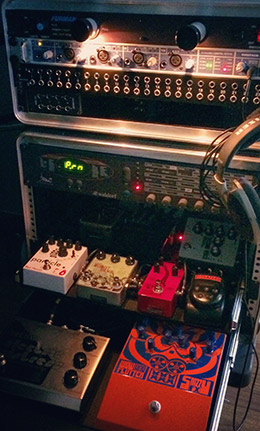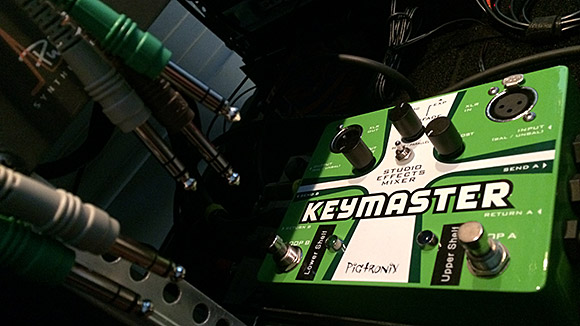Impedance, Effect Pedals, and Sound Design
Posted: June 25th, 2014 | Author: Nathan | Filed under: gear, music, sound design
I favor discrete effects loops on rackmounted shelves, since I’m not a stomping-on-stage kind of guy.
As evidenced by a few recent posts here on Noise Jockey, I think the most exciting way to use guitar-oriented effects pedals is thinking of them as modular synthesizer units. (Indeed, it’s no accident that many boutique pedal makers are now issuing Eurorack versions of their stompboxes.) My workflow usually involves recording signals dry, then running them through the effects as sends. This gives me maximum control when composing, designing, and mixing. I keep my pedals in two distinct loops: One for sculpting and distorting tone, and one for filtering and modulation.
However, just sending signals out to pedals as effect sends from an audio interface doesn’t always work very well. Most effect pedals expect guitars at their front door, not synths, virtual instruments, samples, or field recordings. Most guitars with passive pickups, of course, are high-impedance instrument-level signals, not low-impedance line-level signals that one would expect from hardware synths, virtual instruments, or pre-recorded tracks that are coming back out via an audio interface. This can mean that the effect return might be extremely low, distorted, or noisy/hissy, depending on the signal and what specific pedals are in the effects chain.
So, there are basically two ways to address this problem.
- Use pedals that natively support line-level signals. This usually leads one to higher-end pedals like the Moogerfoogers, and they can be expensive. Rackmount multi-effect units often handle line inputs just fine, but many of those units are also expensive and, in my experience, lack the character and flexibility of a more modular approach of individual pedals. My bigger issue with this approach is that it seems silly to limit one’s creativity based on the vagaries of electrical engineering.
- Use a device in the effects chain to properly match impedances of the sent signal to the effects in the chain. This approach gives the designer, artist, musician, or engineer the best balance of creative freedom while correct managing signal level to optimize frequency response, gain, and noise levels.
DI (direct injection) boxes won’t solve this problem, since they usually output at microphone level – still a high impedance signal. No, dear friends, what you really want is a re-amping device, a box that takes any pre-recorded signal and sends it to a guitar amp or effects chain as a high impedance signal. These are as expensive as decent effect pedals themselves, but worth their weight in gold to treat your audio right and send any signal to any effect. A most egalitarian piece of electronic equipment. Many reamp devices exist, even as 500 series modules!
But remember my two-loop effects chain? Ostensibly I’d need a re-amp on each chain; that sounded expensive. Or so I thought, until I discovered the Pigtronix Keymaster.

There is no impedance, only Zuul.
Besides the obvious bonus of being named after a Ghostbusters reference, the Keymaster has two dedicated re-amping loops, each with a send and return and individual loop output gain knobs. PERFECT. Heck, it even sports XLR I/O for the fancy lads and lasses. As an added weird bonus, it actually has a crossfader between each loop, should one want to switch between the two in real time. While I have used this myself musically, most of the time this large green and white box stays in the back of my effects back near my  power supply, silently channeling and impedance-matching my dry signals into mangled layers of noisy glory.
Many other re-amping boxes exist, and single-channel units are cheaper, but for maximum creative weirdness and flexibility, the Keymaster has become the core of my externalized sound design and musical effects chain, even when it’s simply a silent partner in making noisy things happen. Heck, it even  lets me run them in serial or parallel, and freed up some I/O plugs on my patchbay and audio interface.
So, if you’re interested in experimenting with effects pedals and stomp boxes as external effects devices, grab a re-amping box and hit eBay or your local guitar shop in search of fun stompboxy goodness. We’re in a golden era of boutique audio hardware creation, so there’s no better time to experiment with literally out-of-the-box noisemaking.
Today’s sound is an extremely simple drum loop, but using a bunch of effect pedals, all managed through the Keymaster. First you’ll hear a rhythmic start with just a Dwarfcraft Robot Devil pedal, with only its starved circuit creating the rhythm, being run through a Red Panda Particle pedal set on delay. Then you’ll hear a hi-hat run through a Snazzy FX Wow and Flutter pedal. A dry kick drum then starts, and the snare eventually gets the Red Panda Particle treatment as a super-wet granular delay.
[soundcloud url=”https://api.soundcloud.com/tracks/152340481″ params=”color=ff5500&auto_play=false&hide_related=false&show_artwork=false&show_comments=true&show_user=true&show_reposts=false” width=”100%” height=”166″ iframe=”true” /]
| 12 Comments »
It’s nearly impossible to find knowledgeable people in this particular topic, Haven’t seen a good blog talking about effect pedals for a long time!!U rock!!Dude! Thanks!!!
Oh, the gears are just awesome and I want to have the exact the same one with you, can you give us a list about all the gears u have used? Thank you for sharing this.
That would be a big list, but I’ll run down what you see in the photos: In terms of pedals, my collection is ever-changing (so this list is no longer current), but you see a Snazzy FX Wow & Flutter, Dwarfcraft Devices Robot Devil (discontinued) and Great Destroyer, an old Ibanez overdrive pedal, Red Panda Particle, and Electro-Harmonix Electric Mistress Deluxe (a 90’s re-issue), and an AD 4096. In the rack, you see a Waldorf Pulse Plus analog synth and an RME FireFace 800 interface with a Neutrik patchbay. Hope this answers your question.
Nathan, this is great. Thank you for posting. Although it may seem like a silly question, is the route such that the send from you daw/interface goes to the Pigtronix first,then to your pedals, then back to your interface?
Not a silly question at all, Damion. You are correct about my signal path for pedals: It runs from my DAW to the Keymaster back to the DAW. The only other wrinkle is that it passes through a patchbay, should I want to do something especially funky with either inserting something new into the send, or processing the return before going back into the DAW. For a while I ran two completely separate FX loops, both through the Keymaster, but I found that I used serial/sequential processing a lot more than parallel processing, so I just simplified. Thanks for the great question!
Thanks Nathan!
Nathan, I stumbled upon your blog while wondering if I could insert a second instrument into one of the effects returns of the Keymaster. Can you do live recording while going out of your DAW into the Keymaster, through your effects chain and back into the DAW? Doesn’t this create a feedback loop?
Thanks, Lyle
@Lyle: Keymaster as mixer, then? I suppose you could, yes. An unusual approach better served by a real mixer, though.
As far as live recording out of the DAW and into the Keymaster, yep, I do that all the time! I set up a live input channel (guitar, synth, microphone, or similar) in the DAW to send out to a Keymaster input; then, on a separate channel, I have a track that is recording the Keymaster’s output. The idea (and, IMO, the benefit) is you have two tracks: A wet and a dry. Makes mixing way more flexible. As long as you can monitor the inputs live, this works great, with no feedback. (Of course you CAN set up feedback loops if you want to, which is a different kind of fun! :-D)
Great writeup! I have been using a wounded paw blender to run effects in parallel plus reamp box, the wounded paw features phase switching which is important for blending distortions which sometimes reverse phase. This looks like a great solution that incorporates both, plus DI of the output.
I also have a vfe RUP pedal which blends but also can act as a crossover, with the keymaster, I could take output of dry line level signal from computer, re-amp, split, use the above mentioned boxes for up to 6 loops in parallel, and then mix and return at line level. I also love the idea of pull out shelves in a rack as I prefer to have stomp boxes on a coffee table for easy reach of the knobs, but always run out of room.
Btw to complete the ghostbusters cycle, I see that pigtronix also offers a gatekeeper noisegate. Never bring these two together.
Can you confirm that moogerfoogers do not require a reamp box
I’m afraid that I can’t, as I don’t own any. Worth a check of their manuals or even an email to Moog.
Very impressive.Thank you